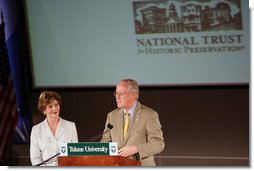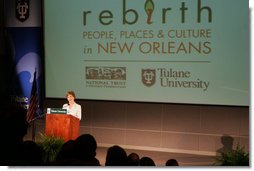|
Home >
News & Policies >
May 2006
|
For Immediate Release
Office of the First Lady
May 31, 2006
Mrs. Bush's Remarks at the National Trust for Historic Preservation's Conference "Rebirth: People, Places and Culture in New Orleans"
Tulane University
New Orleans, Louisiana
11:35 A.M. CDT
MRS. BUSH: Thank you, Dick, for your kind introduction, and thank you for your good work as President of the National Trust for Historic Preservation.
I want to thank the National Trust, Tulane University, Dillard, Xavier, Loyola, and Preservation Resource Center of New Orleans for sponsoring this summit. It's such a very, very important summit. It couldn't come at a more important time for New Orleans and for, frankly, our whole Gulf Coast. So thank you all very much for sponsoring it.
 And I also want to recognize John Nau, the Chairman of the Advisory
Council on Historic Preservation. Thank you for your great work. And
of course, Scott Cohen, the President of Tulane University. Scott's
been a huge advantage for New Orleans since the hurricane. His devotion
to Tulane, but also to the city, is really, really important, and it's
made a huge difference. Seletha Nagin, the wife of New Orleans Mayor
Ray Nagin, Congratulations, Seletha, to both of you, and thank you very
much for joining us today. I also want to thank the members of Congress
and their spouses and other local officials who are here with us.
And I also want to recognize John Nau, the Chairman of the Advisory
Council on Historic Preservation. Thank you for your great work. And
of course, Scott Cohen, the President of Tulane University. Scott's
been a huge advantage for New Orleans since the hurricane. His devotion
to Tulane, but also to the city, is really, really important, and it's
made a huge difference. Seletha Nagin, the wife of New Orleans Mayor
Ray Nagin, Congratulations, Seletha, to both of you, and thank you very
much for joining us today. I also want to thank the members of Congress
and their spouses and other local officials who are here with us.
I'm delighted to be in New Orleans today with so many dedicated preservationists. This year marks the 40th anniversary of the National Historic Preservation Act. This milestone is a perfect opportunity for all of us to take stock of the strides we've made over the last four decades in preservation, and then to determine how best to protect America's rich national heritage into the next century. Today's conference is an important part of that review. Over the next two days, you'll discuss how a rebuilt New Orleans can keep alive its unique parades, festivals and celebrations, how it can preserve its culinary and musical landscapes, and revitalize its historic neighborhoods.
But the discussions you start here will also determine how businesses and foundations, educational institutions, governments, and private citizens can improve our approach to historic preservation throughout the whole United States. These talks will culminate this fall in the Preserve America Summit -- which I'll lead here in New Orleans, in partnership with the Advisory Council on Historic Preservation.
The summit is a vital part of President Bush's Preserve America Initiative, which, as Dick Moe said, he announced in 2003 to encourage communities to preserve our cultural and natural heritage. Preserve America also helps boost local economies, because historical landmarks attract visitors and business.
At this fall's Preserve America Summit, experts and scholars will review our national preservation programs and propose improvements to modernize them, in keeping with the goals of Preserve America. The summit will also help communities throughout the United States make their cultural attractions more accessible to the public and more beneficial to local economies. And this is especially important here on the Gulf Coast, where well-preserved and well-presented history can revive local tourism and speed economic recovery.
 Since last summer's hurricanes, I've paid a lot of attention to the
rebuilding of school libraries. Restocked libraries will be at the
heart of reconstructed and restored schools, and we know that schools
are vital to the recovery of the Gulf Coast. Thousands of families who
have moved away from the Gulf Coast after the hurricanes want to come
home, but they can't come home unless there's a school for their
children.
Since last summer's hurricanes, I've paid a lot of attention to the
rebuilding of school libraries. Restocked libraries will be at the
heart of reconstructed and restored schools, and we know that schools
are vital to the recovery of the Gulf Coast. Thousands of families who
have moved away from the Gulf Coast after the hurricanes want to come
home, but they can't come home unless there's a school for their
children.
During this summit, I urge you to pay attention to our historic school buildings. As we speak right now, a group including Tulane University, Teach for America, and three charter schools is beginning to restore Fortier High School just a few blocks from here. Their work is a great example of how an act of historic preservation can benefit children, and, in fact, benefit entire communities.
The preservation dialogue that you start today in New Orleans will continue throughout the summer and across the country in 11 pre-summit forums, hosted by federal agencies and private sector partners. Each meeting will be co-chaired by respected preservation leaders, and we're privileged that many of those preservation leaders are with us today.
A central element of the Preserve America Summit will be the restoration of historic sites devastated by natural disasters like Hurricane Katrina. Experts will also determine how we can best protect our cultural treasures in disaster-prone regions of the country. This is part of why today's conference is so important to the Preserve America Summit: Many of you have learned firsthand how to preserve cultural treasures in the aftermath of a natural disaster, and you've shown you're eager to share this knowledge.
You're helping New Orleanians bring back their famous historic architecture. Around 20 districts in the New Orleans area appear on the National Register of Historic Places, covering almost 38,000 structures -- from Creole cottages, to shotgun houses, to stately colonial mansions.
After the hurricanes, residents of these historic districts faced an added obstacle: retaining engineers, contractors, and architects to rebuild historic homes according to new regulations. For people who had lost everything, this obstacle seemed insurmountable -- until the National Trust, the Preservation Resource Center, and students from Tulane's architecture school fanned out into the area's historic neighborhoods and showed residents how homes could be reclaimed, offering expertise, comfort, and hope.
With the support of our partners in the Preserve America Summit, you're also helping revive New Orleans' arts and culture. The Getty Foundation established a $2 million fund to help visual arts organizations rescue their collections. The National Endowment for the Arts awarded $500,000 in grants to fund recovery efforts in Louisiana, Mississippi, Alabama, Florida, and Texas. In March, the Institute of Museum and Library Services announced more than $670,000 in grants to help seven museums recover their collections and re-open them to the public.
And today, I'm happy to announce that the IMLS, the Institute of Museum and Library Services, is reserving $1.5 million of the grant money it will award over the next year for projects related to the Gulf Coast and other regions affected by major disasters.
The National Endowment for the Humanities awarded $1 million in emergency grants to 39 preservation projects after Hurricane Katrina, helping these cultural institutions avoid water and mold damage to their collections. The Endowment has since made another quarter-million dollars available.
And I'm happy to announce that the National Endowment for the Humanities will award an additional $750,000 in stabilization grants to cultural and historical institutions along the Gulf Coast. These grants represent a new phase of the recovery, and will support long-term recovery projects to house and display rescued collections.
At the same time, the Endowment recognizes that Katrina is now a defining moment in New Orleans' culture and history. So, with a new $83,000 grant to the Louisiana Endowment for the Humanities, the NEH will help communities document their stories of tragedy and triumph in the aftermath of the hurricane.
With the help of federal partners, businesses, philanthropic foundations, cultural agencies, and all of you, New Orleans will be reborn as the vibrant cultural center that it once was. And making sure visitors can return to New Orleans for its architecture, history, food and jazz will help your overall recovery effort. More important, your work will also have a very real impact on the people whose lives are entwined with this city's culture -- people like Mildred Bennett.
Mildred is 89 years old. She lived in a pink and green shotgun house in the historic Holy Cross section of the Lower Ninth Ward. Her home was built in 1890 as a wedding present for Mildred's great grandmother, Rose Randall. Mildred grew up in that house, her children grew up in that house, and her grandchildren grew up in that house. In 1965, it was their refuge from Hurricane Betsy, when they were rescued from a rooftop by National Guard helicopters after the storm flooded the Lower Ninth Ward. Mildred's home was on higher ground, and it had been spared.
But forty years later, Mildred's home received no mercy from Hurricane Katrina. The shotgun house that had been home to seven generations of Mildred's family -- where they had celebrated decades of 4th of July barbecues, Thanksgivings, and Christmases -- was destroyed by five feet of floodwater. Mildred's granddaughter, Donna, recalls, and I quote: "Rose Randall had always said to my grandmother that this house should remain in the family, that she should never let this house go." But faced with complete devastation, no flood insurance, and poor health, the family home appeared beyond rescue.
When Donna first saw the devastation, she cried in the street in front of Mildred's house. As she wept, Donna was comforted by representatives of the National Trust for Historic Preservation and the Preservation Resource Center who were already there helping Mildred's neighbors. Through tears, Donna told them the story of her family home. The next day, she said, "they asked if they could take it on as a project."
Now, with the help of the National Trust, the Preservation Resource Center, Tulane architecture students, community organizations, and neighborhood volunteers, Mildred's home is being rebuilt. The old shotgun house is also being improved, upgraded with a ramp to accommodate Mildred's wheelchair, and protected against future storms. Along the way, the Resource Center has helped rescue Mildred's priceless family treasures: antique furniture, World War II-era records belonging to her jazz-pianist brother, even Mildred's diary.
When Mildred sees her home restored and improved for the first time next month, Donna says she knows her grandmother's tears will be tears of joy. The house has become a symbol of hope for the entire neighborhood. When volunteers come to work on Mildred's home, Donna says, "then people go next door to help the neighbors. They're spreading the confidence, this belief that the neighborhood can come back, and that it can be revived." Mildred is right here on the front row. (Applause.) And Donna, her granddaughter, and another granddaughter. (Applause.)
Through your work, all of you -- your hard work to preserve New Orleans' history and culture, you are spreading the belief that this city can come back. Thank you very much for your commitment to New Orleans and to the Gulf Coast, and to preservation throughout the United States. I'm looking forward to the great contributions your work here will make to the summit in October, and to historic preservation throughout the United States. Thank you all very, very much. (Applause.)
END 11:49 A.M. CDT
![]() Printer-Friendly Version
Printer-Friendly Version
![]() Email This Page
Email This Page


